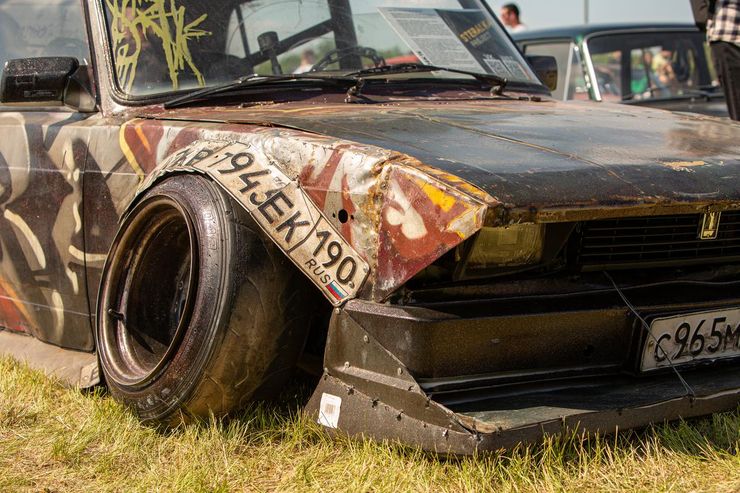Why do wheel arches always rot in Zhiguli?
- July 29, 2022
- 0
In the past, cars were treated differently: they cherished and cherished, crops and ‘movili’. And yet the native Zhigul rusts treacherously, especially in the area of the wheel
In the past, cars were treated differently: they cherished and cherished, crops and ‘movili’. And yet the native Zhigul rusts treacherously, especially in the area of the wheel

What does buying a new car look like today? A signature in the loan agreement, a mandatory photo on the phone – as a memento of a free life without debts – and out on the street. Then the pedal goes to the lowest position and the service is remembered only thanks to the icon on the dashboard. Illuminated – it’s time to record. Even 15 years ago, this procedure looked very different: a new car was immediately taken to a gas station or garage, where everything was stretched, inspected and lubricated. The bottom and sills were immediately coated, although clean and slightly rusty, with special compounds that resisted the formation of corrosion. And only then did it hit the record.
However, Movil is not Movil and after 2-3 winters the edges of the wings in the area of the wheel arches still started to be covered with insidious rust. Is the place cursed? By no means! The fact is that lockers were an obligatory part when preparing a new car to hit the road – they are also mudguards. Plastic molded plates are designed to seal the delicate interior of the arches from dirt and water, preserving the iron for many years. The lockers accomplished this task quite well, but the problem was hidden where they were not expected.
First of all, the fender liner didn’t stick around forever. Periodically, at least once a year, they had to be removed and the cavities washed, which, of course, no one did. This created a dense layer of wet earth between the iron and the plastics – arguably the best atmosphere for the appearance of rye. But this too was not a major problem, because the arches were covered with movable and pushsal, and therefore withstood human laziness for a long time.
The main reason for the appearance of rust on the wheel arches of a domestic car was the way in which the fender trim was installed. They were fastened and are still fastened with a self-tapping screw – a “seed”, he is also a garden screw, with which they simply pulled plastic into iron. Simply put, they artificially violated the metal’s protective paint coating, accelerating the appearance of rust and corrosion dozens of times.
How different, you ask? Yes, it’s very simple: after you drill a hole to fix the locker, you need to close the bare metal again, and by any means necessary. Paint and varnish work, by the way, also anti-gravel, as well as many other remnants of paintwork that are easy to find in any garage. In addition, any protective varnish will fit, if done carefully, it will not be visible – the self-tapping screw closes everything with a “cap”. Who did it? Only the person who installed the lockers themselves, and not in a “professional workshop”. So the “sixes”, “sevens” and “nine” rode with rotten wings forever, no matter how much Movil you pour on them.

What does buying a new car look like today? A signature in the loan agreement, a mandatory photo on the phone – as a reminder of a free life without debts – and out on the street. Then the pedal goes to the lowest position and the service is remembered only thanks to the icon on the dashboard. Illuminated – it’s time to record. Even 15 years ago, this procedure looked very different: a new car was immediately taken to a gas station or garage, where everything was stretched, inspected and lubricated. The bottom and sills were immediately coated, although clean and slightly rusty, with special compounds that resisted the formation of corrosion. And only then did it hit the record.
However, Movil is not Movil and after 2-3 winters the edges of the wings in the area of the wheel arches still started to be covered with insidious rust. Is the place cursed? By no means! The fact is that lockers were an obligatory part when preparing a new car to hit the road – they are also mudguards. Plastic molded plates are designed to seal the delicate interior of the arches from dirt and water, preserving the iron for many years. The lockers accomplished this task quite well, but the problem was hidden where they were not expected.
First of all, the fender liner didn’t stick around forever. Periodically, at least once a year, they had to be removed and the cavities washed, which, of course, no one did. This created a dense layer of wet earth between the iron and the plastics – arguably the best atmosphere for the appearance of rye. But this too was not a major problem, because the arches were covered with movable and pushsal, and therefore withstood human laziness for a long time.
The main reason for the appearance of rust on the wheel arches of a domestic car was the way in which the fender trim was installed. They were fastened and are still fastened with a self-tapping screw – a “seed”, he is also a garden screw, with which they simply pulled plastic into iron. Simply put, they artificially violated the metal’s protective paint coating, accelerating the appearance of rust and corrosion dozens of times.
How different, you ask? Yes, it’s very simple: after you drill a hole to fix the locker, you need to close the bare metal again, and by any means necessary. Paint and varnish work, by the way, also anti-gravel, as well as many other remnants of paintwork that are easy to find in any garage. In addition, any protective varnish will fit, if done carefully, it will not be visible – the self-tapping screw closes everything with a “cap”. Who did it? Only the person who installed the lockers themselves, and not in a “professional workshop”. So the “sixes”, “sevens” and “nine” rode with rotten wings forever, no matter how much Movil you pour on them.
Source: Avto Vzglyad
I’m Sandra Torres, a passionate journalist and content creator. My specialty lies in covering the latest gadgets, trends and tech news for Div Bracket. With over 5 years of experience as a professional writer, I have built up an impressive portfolio of published works that showcase my expertise in this field.